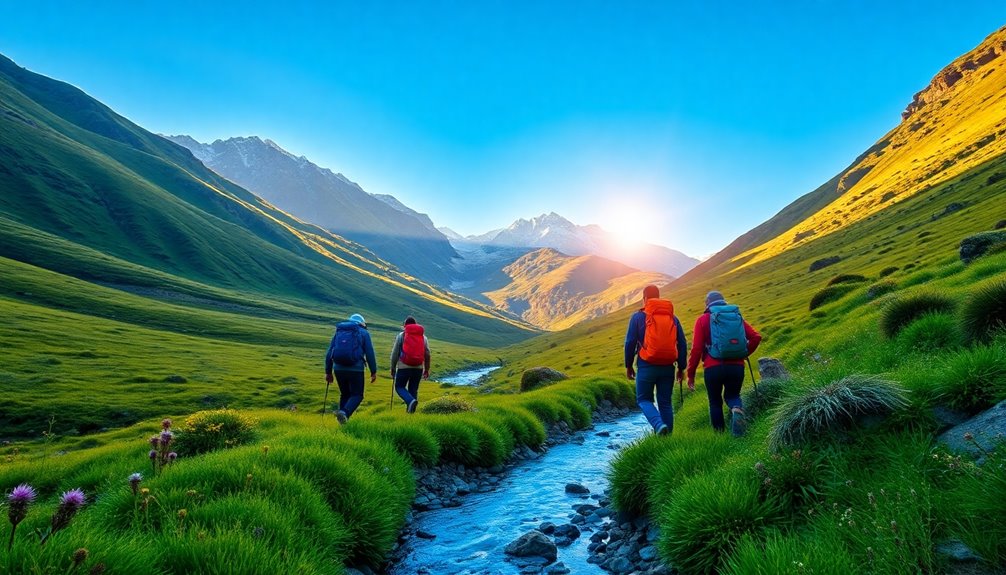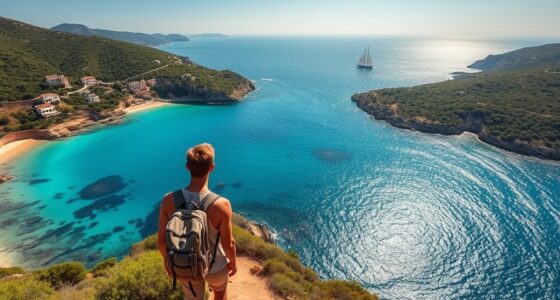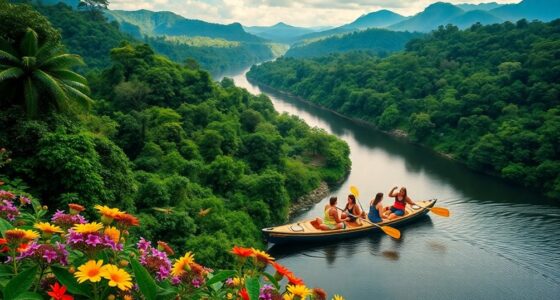In Peru, you can experience sustainable adventures that combine adventure with eco-consciousness. You'll find eco-friendly accommodations and dining options that prioritize local produce and minimize waste. Participating in community-led reforestation projects helps restore native habitats while engaging with local cultures deepens your understanding of the region. Whether you're trekking through the Amazon or exploring Machu Picchu, each choice you make contributes to preserving Peru's incredible biodiversity. With the best months for eco-tourism being May to September, you're set for an unforgettable trip. Keep going to uncover other ways to enhance your sustainable travel experience.
Key Takeaways
- Explore Peru's diverse ecosystems through eco-friendly accommodations like Inkaterra, emphasizing conservation and local culture.
- Participate in community-led reforestation projects to actively contribute to biodiversity preservation and climate change mitigation.
- Engage in sustainable tourism practices, including farm-to-table dining and responsible wildlife viewing, to support local economies and protect habitats.
- Experience authentic cultural interactions by learning basic Quechua phrases and joining local festivals or cooking classes.
- Take advantage of eco-tourism seasons from May to September for optimal wildlife viewing and exploring natural wonders like Machu Picchu.
Introduction
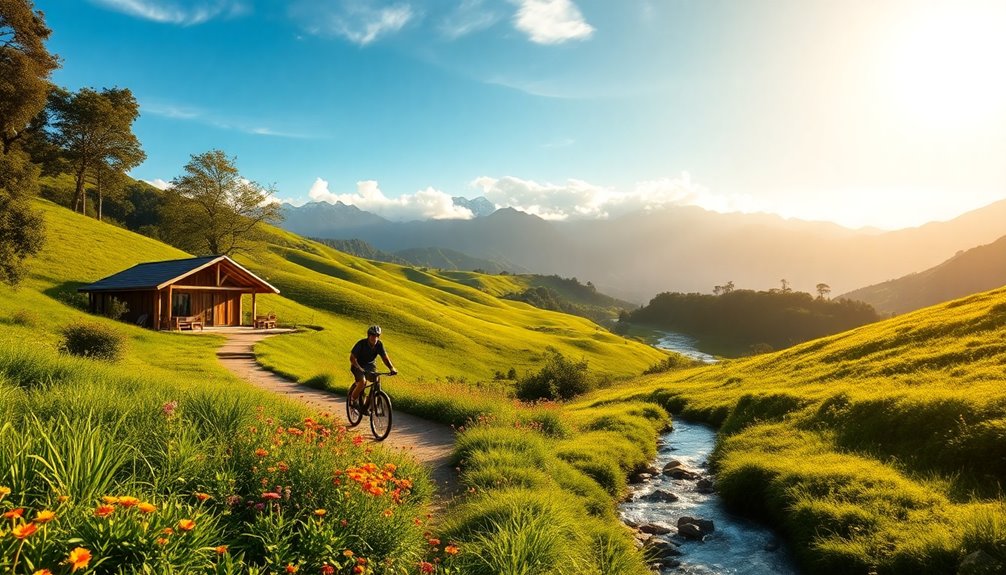
When you explore Peru, you'll discover its incredible diversity of ecosystems and rich cultures.
This vibrant country is home to unique biodiversity, and sustainable adventures help preserve it for future generations.
Diverse Ecosystems and Cultures
Peru's remarkable diversity of ecosystems and cultures invites you to explore a land where nature and tradition intertwine.
With over 28 distinct ecosystems, from coastal deserts to the Amazon rainforest, you'll encounter an incredible array of flora and fauna, including 25,000 plant species and 1,800 bird species.
Immerse yourself in the rich cultural heritage of Peru's indigenous peoples, like the Inca and Amazonian tribes, who practice sustainable tourism practices that honor their environments.
Festivals, such as Inti Raymi, showcase these traditions and deepen your connection to the land.
As you traverse the Andes, you'll appreciate how the varied climates and habitats support unique wildlife, making your journey both enriching and vital for conservation efforts. Additionally, wild edibles like wild garlic and other local plants can enhance your travel experiences while promoting sustainable foraging practices.
Preserving Peru's Unique Biodiversity
As you explore the breathtaking landscapes of Peru, you'll quickly realize the importance of preserving its unique biodiversity.
With over 25,000 plant species and 1,800 bird species, Peru stands out as one of the most biodiverse countries in the world. The Amazon rainforest, covering 60% of the territory, not only supports countless species but also plays a vital role in global carbon storage.
By choosing sustainable travel options, like eco-friendly accommodations and responsible trekking, you help protect the environment while enjoying the beauty of places like Manu and Huascarán National Parks.
Engage in conservation efforts aimed at endangered species and combat habitat loss. Your choices can significantly contribute to preserving Peru's incredible ecosystems for future generations.
Travel From Lima to Cusco
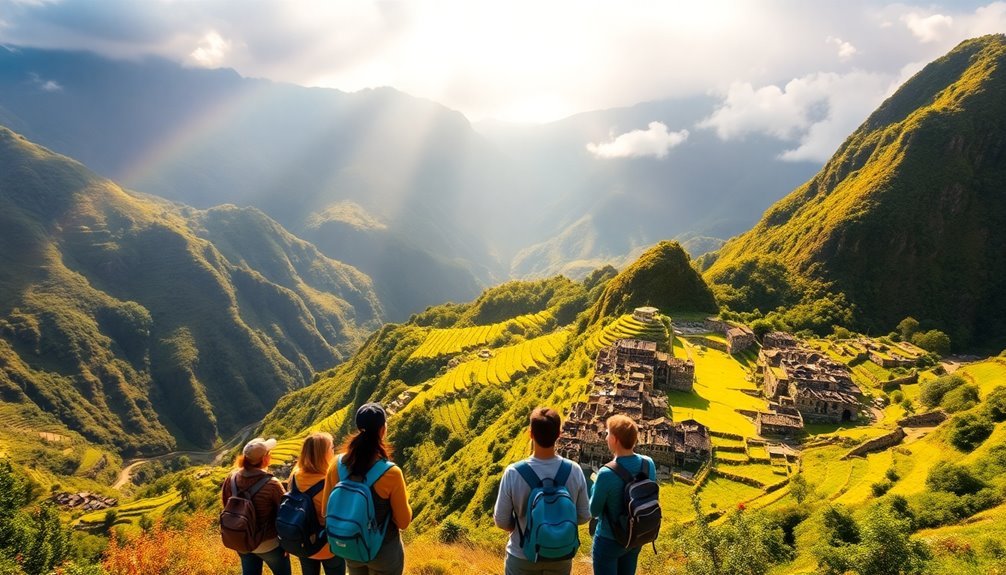
When you're ready to travel from Lima to Cusco, there are several flight options to consider, whether you're coming from the USA, Europe, or Sydney.
You can also explore eco-friendly public transit choices that help reduce your carbon footprint while enjoying stunning views along the way.
Whichever route you choose, you'll soon find yourself immersed in Cusco's rich culture and breathtaking landscapes.
Flights to Cusco From USA
Wondering how to get to Cusco from the USA? You'll first need to book a flight to Lima, Peru, as there are no direct flights to Cusco.
Major airlines like LATAM, Sky Airline, and Viva Air offer multiple daily flights from Lima to Cusco. These flights usually take about 1 hour and 20 minutes and cover roughly 600 kilometers.
Prices typically range from $50 to $150 USD, especially if you book in advance during peak seasons.
To travel green, consider choosing airlines with eco-friendly practices and offsetting your carbon footprint.
Flights From Europe to Cusco
How do you get from Europe to Cusco?
To travel from Europe to Cusco, you'll typically need to book flights from Europe to Lima first, as Cusco's Alejandro Velasco Astete International Airport mainly handles domestic flights.
Major airlines like LATAM, Avianca, and Iberia offer connecting flights from Lima to Cusco, which take around 1 hour and 30 minutes.
Since the total travel time can range from 15 to 20 hours, it's wise to plan ahead, especially during peak tourism in Peru.
Also, remember to acclimatize in Lima before heading to Cusco to avoid altitude sickness.
Booking your Lima to Cusco flights in advance ensures you get better rates and availability.
Flights From Sydney to Cusco
Navigating your way from Sydney to Cusco can be an adventure in itself.
You'll first need to find flights from Sydney to Lima, which usually involve at least one stopover in cities like Santiago, Auckland, or Los Angeles. Expect total travel times of around 20 to 30 hours.
Once you land in Lima, book a domestic flight to Cusco, taking just over an hour. Airlines like LATAM and Avianca offer multiple daily options.
Given Cusco's altitude of over 10,000 feet, it's smart to acclimatize in Lima for a day to avoid altitude sickness.
If you're eyeing the Inca Trail or other treks, secure your permits and flights early—responsible trekking starts with planning!
Eco-Friendly Public Transit Options
Once you've arrived in Lima, consider taking the bus to Cusco for a more eco-friendly travel option. This journey takes about 21-24 hours, offering stunning views of the Andes and chances to engage with local culture. Major companies like Cruz del Sur and Oltursa prioritize sustainability with eco-friendly practices, including biodegradable materials.
| Benefit | Description |
|---|---|
| Eco-Friendly Travel | Significantly lower carbon emissions |
| Scenic Route | Experience picturesque towns |
| Support Local Economy | Boost local businesses along the way |
Opt for an overnight bus with reclining seats to reduce accommodation needs while minimizing your environmental impact. This way, you can enjoy a sustainable adventure while immersing yourself in Peru's beauty. Additionally, using eco-friendly practices during your travels can further enhance your commitment to reducing your carbon footprint.
Nature Reserves and Conservation Areas
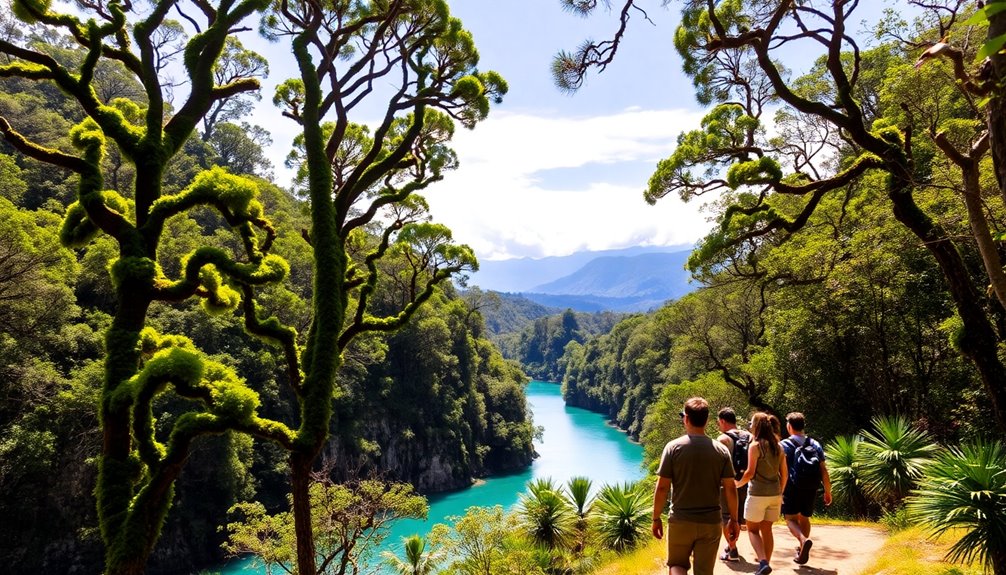
When you explore Peru's nature reserves, you'll find incredible opportunities for wildlife conservation tours and unforgettable wildlife watching experiences.
Many lodges in these areas focus on sustainable practices, ensuring your stay supports local ecosystems. By choosing these options, you're contributing to the preservation of Peru's rich biodiversity.
Wildlife Conservation Tours
Exploring Peru's wildlife conservation tours offers a unique opportunity to connect with nature while supporting vital ecological efforts.
These tours not only highlight the stunning biodiversity but also promote sustainable practices that benefit both wildlife and local communities.
Here are three key aspects of these tours:
- Hands-On Experience: Participate in reforestation projects and learn about local conservation initiatives.
- Educational Opportunities: Gain insight into the importance of wildlife conservation and the ecosystems that support it.
- Support Local Communities: Engage with initiatives like the Ocean & Forest Project, which helps reduce illegal fishing and promotes sustainable livelihoods.
Wildlife Watching Tours
Have you ever dreamt of witnessing wildlife in its natural habitat? Peru offers incredible wildlife watching tours in conservation areas like Manu National Park and Tambopata National Reserve. You'll spot over 1,000 bird species, playful monkeys, and elusive jaguars, all while learning about vital conservation efforts.
| Species | Habitat | Conservation Status |
|---|---|---|
| Giant River Otter | Amazon River | Endangered |
| Scarlet Macaw | Rainforest Canopy | Near Threatened |
| Capuchin Monkey | Forest Understory | Least Concern |
| Jaguar | Forest Floor | Near Threatened |
These tours emphasize responsible practices, ensuring that your experience supports local initiatives and minimizes human impact. Dive into Peru's biodiversity and embrace the adventure!
Sustainable Lodging Options Available
While traveling through Peru's stunning landscapes, you'll discover a variety of sustainable lodging options that enhance your adventure.
Eco-friendly hotels like Inkaterra focus on conservation and local culture, providing unique experiences in nature reserves and conservation areas.
Here are three reasons to choose these sustainable lodgings:
- Biodiversity Experience: You'll immerse yourself in rich ecosystems while supporting environmental protection efforts.
- Community Support: Your stay contributes to local initiatives, like reforestation and cultural preservation.
- Lower Environmental Impact: Smaller, owner-managed accommodations reduce your carbon footprint compared to large hotels. Additionally, incorporating aromatherapy practices during your stay can enhance relaxation and well-being in these natural settings.
Eco-Friendly Dining Options
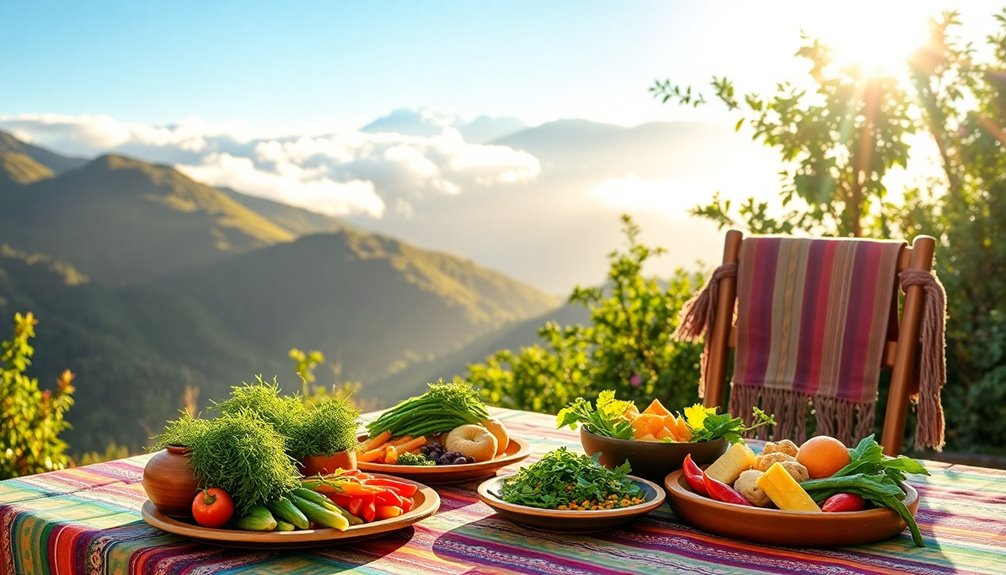
When you choose to dine in Peru, you'll find an array of eco-friendly options that not only tantalize your taste buds but also support sustainable practices.
Many restaurants prioritize farm-to-table practices, sourcing ingredients from local organic farms. You can indulge in traditional Peruvian dishes made from sustainable seafood and locally grown produce like quinoa and potatoes.
Venues like El Albergue in Ollantaytambo grow their own organic ingredients, ensuring freshness while reducing emissions. Some establishments actively compost food scraps and minimize single-use plastics.
By dining at these eco-friendly spots, you're directly contributing to community-supported agriculture programs, enhancing local farmers' livelihoods, and promoting biodiversity.
Don't hesitate to ask local guides for their recommendations on the best sustainable dining experiences!
Community-led Reforestation Projects
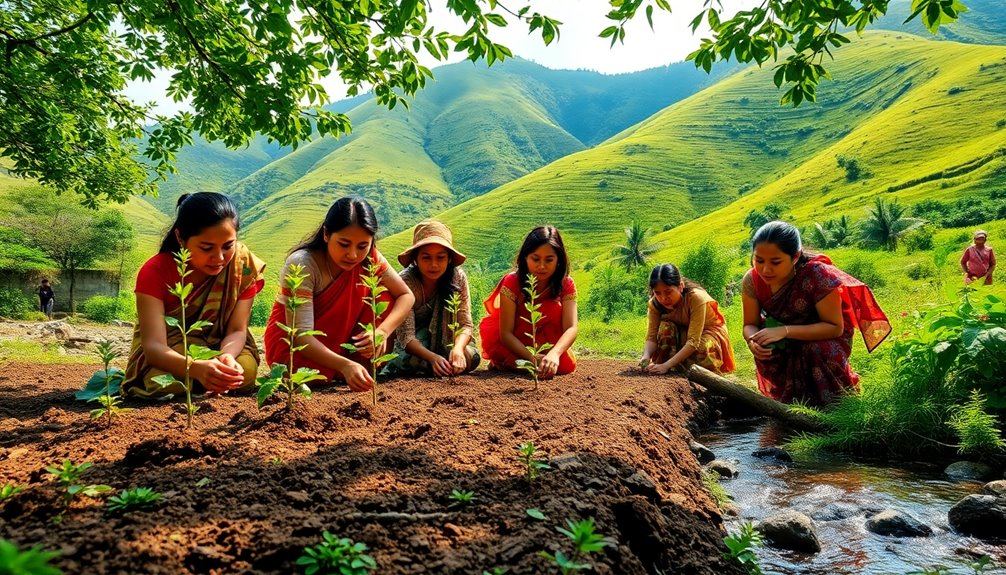
When you explore community-led reforestation projects in Peru, you'll see how local efforts are supported by both government initiatives and NGOs.
These collaborations not only restore degraded lands but also empower communities to sustain their cultural practices and natural resources.
Government and NGO Efforts
As communities in Peru take charge of reforestation efforts, both the government and NGOs play crucial roles in supporting these initiatives. Together, they tackle biodiversity loss and climate change by focusing on sustainable land management and community training.
Here are three key ways their collaboration makes a difference:
- Tree Planting: Initiatives aim to plant millions of native trees each year, restoring deforested areas.
- Training Programs: The government, through SERFOR, provides training in sustainable forestry practices, empowering local communities.
- Awareness Campaigns: NGOs like Conservación Amazónica (ACCA) run educational programs that increase community participation and promote long-term conservation.
These combined efforts lead to healthier ecosystems and enhance the survival of endangered species across Peru.
Community and Cultural Sustainability
How can community-led reforestation projects transform local ecosystems and cultures in Peru? By engaging local communities in planting native trees, these initiatives not only restore biodiversity but also empower residents to take charge of their environmental stewardship.
Organizations like Inkaterra Asociación illustrate how reforestation is intertwined with sustainable development and local livelihoods. As communities actively participate in these projects, they develop a stronger connection to their natural resources, fostering a culture of conservation.
Educational programs that accompany these efforts raise awareness about environmental issues, especially among youth. Ultimately, these projects contribute to carbon offsetting, helping combat climate change while reinforcing the vital link between healthy ecosystems and vibrant communities.
Together, they pave the way for a sustainable future in Peru.
Optimal Months for Eco-Tourism
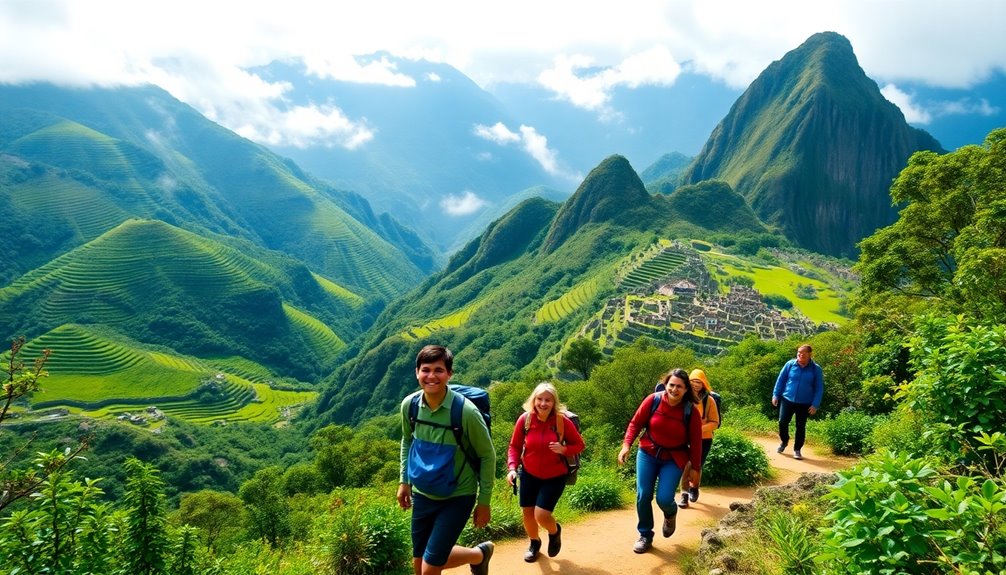
If you're planning an eco-tourism trip to Peru, the best months to visit are from May to September.
This dry season offers perfect weather for trekking and exploring the stunning landscapes, especially in the highlands and the Amazon rainforest.
Plus, you'll get to witness vibrant wildlife and seasonal blooms, making your adventure even more memorable.
Best Months for Ecotourism
The ideal months for ecotourism in Peru fall between May and September, when the dry season reigns supreme. This period not only offers great weather for trekking but also enhances your wildlife observation experiences.
Consider these highlights:
- Machu Picchu Visibility: June and July provide optimal visibility at this iconic site, making it a perfect time for exploring.
- Amazon Rainforest Comfort: From June to August, milder temperatures and lower humidity create ideal conditions for discovering the rainforest's rich biodiversity.
- Birdwatching Bonanza: September to November is prime time for spotting migratory birds, enhancing your ecotourism adventures.
Avoid visiting in February, as heavy rains can disrupt your plans.
Embrace these months for an unforgettable journey through Peru's natural wonders!
Seasonal Rainfall Patterns
While planning your eco-tourism adventure in Peru, it's essential to understand the seasonal rainfall patterns that can impact your experience. The peak eco-tourism season runs from May to September, when you'll find minimal rainfall and perfect conditions for trekking. However, if you're keen on experiencing the Amazon's biodiversity, the rainy season from November to March offers a unique allure. Just be prepared for muddy trails in January and February, particularly around the Sacred Valley and Machu Picchu. For a balanced experience, consider the transitional months of April and October, where milder weather and fewer tourists create a serene atmosphere.
| Month | Rainfall Level |
|---|---|
| May – Sep | Low |
| Oct – Apr | Moderate |
| Nov – Mar | High |
| Jan – Feb | Very High |
How to Make Your Trip More Sustainable
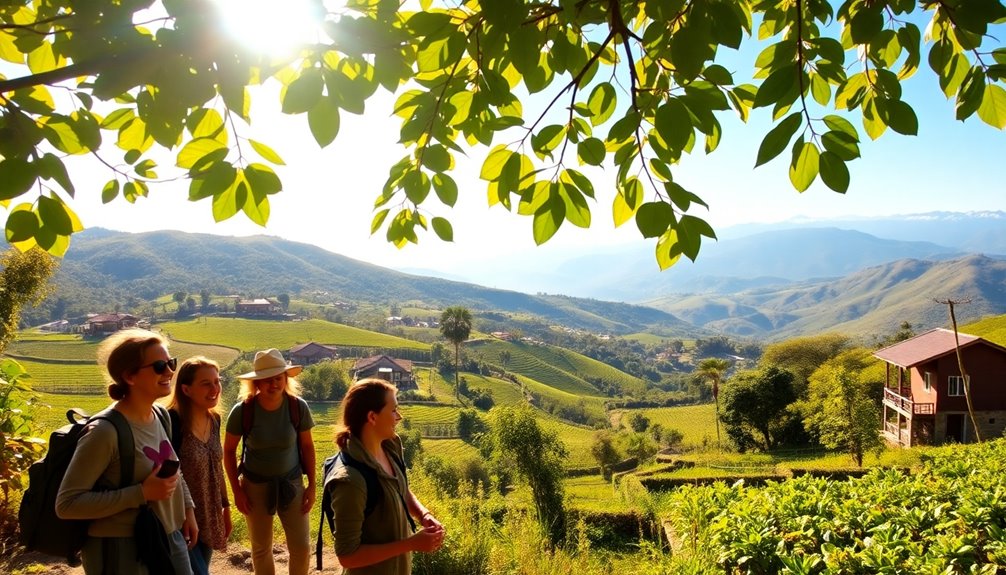
To make your trip to Peru more sustainable, consider using biodegradable toiletries and containers that minimize environmental impact.
It's also crucial to embrace cultural sensitivity by respecting local customs and traditions during your travels.
Biodegradable Toiletries and Containers
When planning your sustainable adventure in Peru, choosing biodegradable toiletries and containers can significantly reduce your environmental impact. These eco-friendly options help lower plastic waste and protect pristine ecosystems.
Here are three essential items to consider:
- Shampoo and conditioner bars – They break down naturally and eliminate plastic bottles.
- Toothpaste tablets – A handy alternative that's waste-free and easy to pack.
- Biodegradable wet wipes and toilet paper – Ensure personal hygiene practices won't pollute sensitive areas like the Amazon rainforest.
Opting for containers made from cornstarch or recycled paper also supports responsible consumption.
Plus, carrying a reusable toiletry bag means you won't need single-use products, further reducing waste during your travels.
Cultural Sensitivity in Travel
Engaging with local cultures not only enriches your travel experience but also promotes sustainability in Peru. By participating in traditional festivals or opting for homestays, you foster cultural exchange and support local families.
Choose indigenous-owned tour operators, like Green Peru Adventures, to ensure your travel budget benefits the community and helps preserve their heritage. Learning basic phrases in Quechua or Spanish shows respect and enhances your interactions with locals, making your journey more authentic.
Always be mindful of cultural customs—ask for permission before taking photos of people or sacred sites. Additionally, consider participating in community service projects, which allow you to give back while gaining deeper insight into local challenges and customs. Successful relationships often stem from mutual respect and understanding, which parallels your interactions with local communities.
Frequently Asked Questions
Is 7 Days in Peru Enough?
Seven days in Peru can be enough for a memorable experience, but it really depends on what you want to see.
You can explore major highlights like Cusco, the Sacred Valley, and Machu Picchu, but you might miss deeper cultural and natural insights.
If you prioritize your itinerary and engage in local activities, you'll create lasting memories.
Just remember, a longer stay would give you a richer understanding of Peru's diverse beauty.
Why Is Peru Good for Adventure Tourism?
Peru's an incredible destination for adventure tourism because it offers diverse ecosystems, from the Amazon rainforest to the Andes mountains.
You can trek the famous Inca Trail, experience breathtaking landscapes, and explore ancient ruins. Wildlife watching and water sports are also popular activities.
Plus, by choosing eco-friendly options, you'll support local communities and contribute to conservation efforts, making your adventures not only thrilling but also responsible and sustainable.
It's an unforgettable experience waiting for you!
Is Peru an Eco-Friendly Country?
Yes, Peru is an eco-friendly country.
You'll find numerous initiatives focused on sustainability, especially in national parks and reserves. Eco-friendly accommodations prioritize environmental conservation, and projects like the PET waste compactor near Machu Picchu show a commitment to reducing plastic waste.
Plus, the government promotes responsible tourism, encouraging you to engage in activities that support local economies and wildlife conservation.
You'll definitely feel the positive impact of your travel choices here.
Why Is Peru Popular for Tourists?
They say, "Variety is the spice of life," and Peru certainly spices up travel with its breathtaking landscapes and rich culture.
You'll be captivated by iconic landmarks like Machu Picchu and vibrant festivals that showcase its Incan and colonial heritage.
Plus, the diverse ecosystems, from the Amazon to the Andes, beckon adventure seekers like you.
With a commitment to sustainable tourism, you'll feel good knowing your travels support local communities and conservation efforts.
Conclusion
As you embark on your sustainable adventure through Peru, think of yourself as a seed planted in rich soil, growing amidst the vibrant tapestry of nature. Each choice you make—whether it's supporting local communities or dining at eco-friendly spots—nurtures this seed, helping it blossom into a thriving tree of positive impact. By embracing these green practices, you're not just traveling; you're cultivating a future where both you and the planet flourish together.

